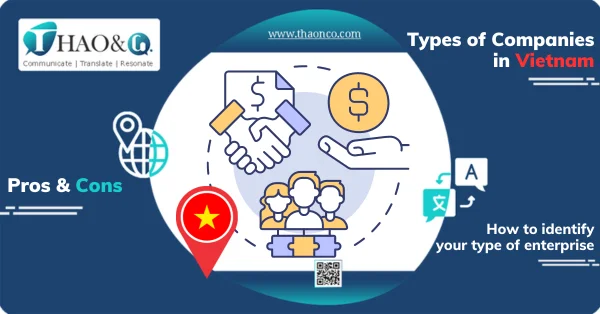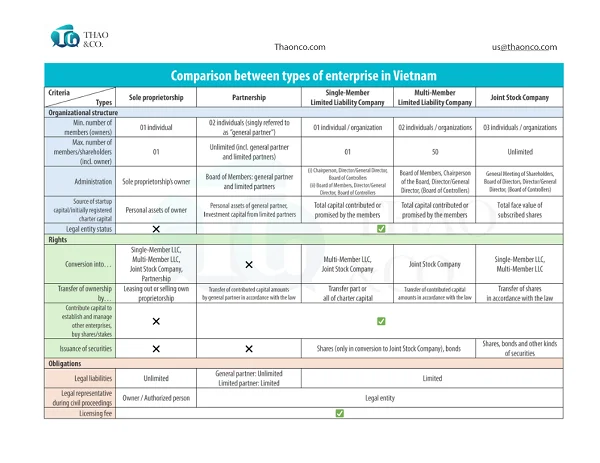Vietnam is a rapidly growing economy with a diverse system of enterprise classification. Different types of companies in Vietnam have different features, advantages, and disadvantages.
Check out this article by Thao & Co. to learn all about Vietnam’s enterprise classification and pick the best for your business.
Currently, Vietnam recognizes 5 types of enterprises. They are:
Each type of enterprise has distinct features concerning business operations, capital contributions, and legal responsibilities of owner(s).
Hence, when setting up a business in Vietnam, it is crucial to understand how different types of companies operate.
Choosing the right type of enterprise can help you minimize the risk of legal and financial complications in the future.

Not sure which type of enterprise to register your business in Vietnam? Here’s a breakdown of the 5 types of companies in Vietnam, complete with the advantages and disadvantages of each type.
A sole proprietorship is an enterprise owned by a single individual. The owner of a sole proprietorship is liable for all activities of the enterprise and there’s no separation between their assets and assets of the enterprise. Each individual may establish only one sole proprietorship.
Advantages:
Disadvantages:
A partnership must have at least 2 partners who are joint owners of the company and operate under one shared name. The owners are referred to as general partners. General partners are liable for the obligations of the partnership with their entire assets.
Besides the general partners, a partnership may also have multiple limited partners. Limited partners are only liable for the debts of the partnership within the capital amounts they have contributed.
Advantages:
Disadvantages:
A single-member limited liability company is owned by either an organization or individual. The owner is liable for all debts and asset obligations within the company’s charter capital.
Advantages:
Disadvantages:
A two-member limited liability company can have between 2 to 50 members. All members are liable for the company’s debts and asset obligation, but only within the capital amounts they contributed.
Advantages:
Disadvantages:
A joint-stock company is a business structure where the charter capital is divided into equal portions called shares. Shareholders own these shares and are only responsible for the company’s debts or obligations up to the amount they’ve contributed.
To form a joint-stock company, at least 3 shareholders are required, though there’s no upper limit on the number. A joint-stock company has legal entity status and can issue shares in accordance with the law.
Advantages:
Disadvantages:
Thao & Co. compares different types of companies in Vietnam to help you choose the right structure for your business.

🔽Download Thao & Co.’s guide on types of companies in Vietnam
The structure of your company plays a crucial role in shaping its business decisions, especially when it comes to issuing bonds, shares, and other securities for expansion. Let’s look at two prominent examples in Vietnam:
Vinamilk Joint-Stock Company
Saigon Pharmaceutical One Member Limited Company (Sapharco)
In Vietnam, the most popular business structure is the Limited-Liability Company (LLC). It’s a top choice for many due to several key advantages:
With an LLC, members are only liable for the company’s debts and asset obligations up to the capital amounts they contributed.
This separates personal and business finances, thus mitigating financial risks for capital contributors.
LLCs offer straightforward procedures for capital contributions, without requiring large capital contributions. However, when a member wishes to transfer their capital, all other members must agree to the transfer.
Current members are also given priority to purchase any transferred shares, providing more control over ownership and preventing outsiders from taking over the company.
Another major benefit is the freedom to operate in any business sector, as long as it is not restricted or prohibited by law.
We hope this article has helped you get a better understanding of the types of companies in Vietnam. Your choice of company structure will significantly impact your future business operations, goals, expansions, and long-term success.
Choosing the right type of enterprise and completing the required legal procedures can be challenging, especially for foreign investors when expanding their business into Vietnam.
As a local agency with proficient English, Thao & Co. can be your partner in conquering the Vietnam market. Our services include:
For more information or to get started, simply fill out our Contact form. Thao & Co. will promptly reach out to provide you with a personalized consultation to help you succeed in Vietnam.
Get in touch:
Address: Floor 3, 86 Dien Bien Phu Street, Da Kao Ward, District 1, Ho Chi Minh City, Vietnam (Google Maps)
Phone: (+84) 28 6682 6636
Email: [email protected]